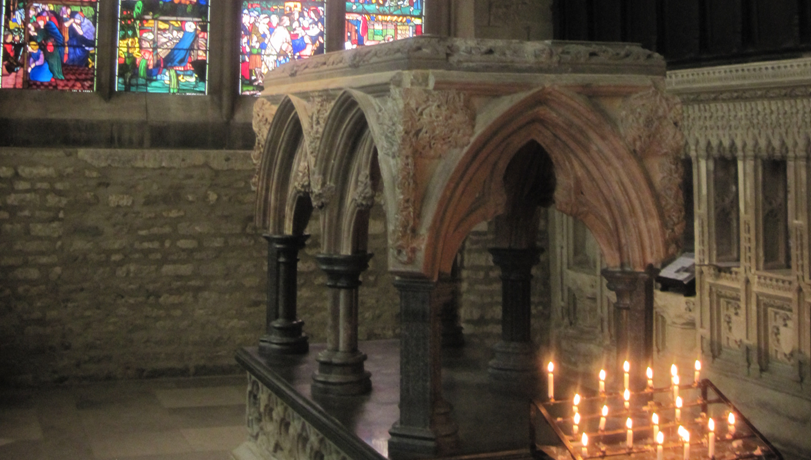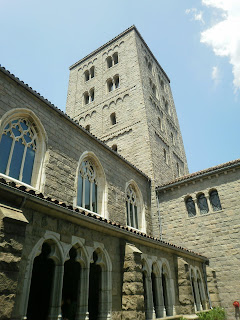Saints, Pilgrimage, Liturgy, Art, Music, Tradition, Faith, the Gospels and the Apostolic Church; Our Devotion from the Resurrection,to the Middle Ages, to Now +

Shrine of St. Frideswide, Christ Church Cathedral Oxford.
Friday, July 22, 2011
Feast, July 25; St. James the Greater
Saint James most famous for being one of the first disciples of Jesus and for being the only Apostle whose martyrdom was recorded in the Gospels. After Pentecost James preached the Gospels to the Galicians in northern Spain. James is the patron Saint of Spain due to the finding of his tomb in Galicia in the early Middle Ages. Since then he has been venerated at the Cathedral of Santiago de Compostela in Spain, where a shrine withholding his relics is kept. Compostela ranked as one of the major pilgrimage sites in Christendom, attracting pilgrims by the tens of thousands along several pilgrimage routes, one of which was mapped out in the 12th century Clunaic manuscript called Codex Calixstinus. The Cathedral Still attracts thousands of pilgrims, and it still continues the ancient tradition of censing the pilgrims at the mass with a giant thurible. It is also the only mass during the year when the Cathedral is aloud to use the medieval Spanish rite, instead of the universal Roman one. The thurible is still used, and this Sunday, the 25, a pilgrims mass will be held at the Cathedral. At top is a view of the Cathedral, then a leaf from the Codex Calixstinus, and finally an image of the thurible.
Feast, July 23; Bridget of Sweden
Saint Bridget of Sweden lived from 1303 to 1373, and is the patron saint of Sweden. In the first part of her life she spent time as a lady-in-waiting for the royal house of Sweden during the reign of King Magnus II. during this time she experienced several visions of the Nativity. In response to these visions she went on several pilgrimages including the one to Trondheim Cathedral (the site of St. Olaf's shrine) and to Santiago de Compostela. After the death of her husband she founded a monastery at Vadstena, where she also established her own rule. She died in Italy after receiving approval for her order. She was canonized in 1391. Her relics survive in a shrine at the re-founded nunnery at Vadstena which is pictured above.
Thursday, July 21, 2011
Feast, July 22; Mary Magdalene
Saint Mary Magdalene was a close friend and follower of Jesus, and is known as an equal or even as one of the Apostles. At the Last Supper it was she who washed and anointed the feet of Jesus, an act which has become a penitential tradition celebrated on Maundy Thursday. Later at the Crucifixion she stayed, kneeling before the cross, with St. Mary the Virgin and with St. John. And most importantly she was the first to go to the tomb and see the risen Christ. Her cult is wide-spread, and she continues to be venerated in the Lutheran, Roman, Anglican, and Orthodox churches. Above is an image of the Stabat Mater scene, Mary Magdalene is kneeling before the cross.
Wednesday, July 20, 2011
Feast, July 21; Arbogast of Strasbourg
Saint Arbogast was one of a series of missionaries who came to preach the Gospel to the Germanic peoples in the seventh and eight centuries. Living first as a hermit in a nearby forest, he was later consecrated the bishop of Strasbourg in the 600s on command of King Dagobert. During his episcopate he founded several churches including the monastery at Surbourg, and was credited for many miracles. He died in 678, and sadly his relics were destroyed by Protestants during the Reformation. Above is his Abbey at Surbourg.
Tuesday, July 19, 2011
Feast, July 20; Margret of Antioch
St. Margaret lived during the prosecution under the Emperor Diocletian. She was a shepherdess who converted many followers to Christianity in the area around Antioch. Both she and those she had converted were martyred in the time of the prosecution. Before she died she proclaimed " that those who dedicate churches and burn lights in her honor will receive they need through prayer". Her Cult was wide spread in England where more than 200 churches are dedicated to her. Above is an illuminated manuscript portraying St. Margret with the dragon.
Feast, July 18; Edburga of Bicester
St. Edburga lived in the early seventh century, and was the daughter of the ruthless pagan king, Penda of Mercia. She became a nun at Castor and later the Abbess of a nunnery she built with her sister St. Edith at Aylesbury. Her relics were later translated to a house of Austin Canons in Bicester where the base of her shrine survives. Above is an image of pilgrims venerating her relics at the shrine.
Feast, July 16; St. Osmund
Osmund was the first Norman Bishop of Sarum England (now Salisbury). He was consecrated bishop in 1078 under William I. During his episcopate he built the cathedral at Old Sarum within the Norman castle, and helped put together the Domesday book for William I, presented to the king at Sarum in 1086. Osmund was admired for his kindness which was unusual for the Norman hierarchy in his time, as his reverence for the Anglo-Saxon saints such as St. Aldhelm Whom Osmund greatly respected. He had a love for books, making several of them himself and is credited for putting together the Sarum Rite, by collecting the various rites used across England. He died in 1099 and although pilgrims came to his tomb soon after, he was not canonized until 1457 when his relics were translated to a new shrine on this day. His tomb in Salisbury Cathedral is pictured above.
Monday, July 18, 2011
The Cloisters Museum & Gardens, and St. John the Divine (Cathedral)
Last week I visited the cloisters museum in NYC. Its a museum especially for medieval religious art. The building itself is made up of bits and pieces of monasteries from all over Europe, including several chapels, cloisters, decorated doorways, and a chapter house. The collection is every thing from paneled altarpieces to gilded reliquaries, and even a monastic garden in one of the cloisters. (3 top photos)
After the cloisters I visited the Episcopal Cathedral of St. John the Divine, the largest Cathedral in the world, and third largest church. the nave is in the Gothic style but the rest is more Romanesque, the crossing being a dome and the apse rendering an impression of Canterbury's trinity chapel. The chapels in the retro-quire are dedicated to a variety of saints and are built in the most well known style of its saint's nation. (3 bottom photos)
On Sunday I also passed the Episcopal Cathedral of the Incarnation in Garden City, NY. The Cathedral is relatively small, but its stone work is exquisite and it is very tall.
After the cloisters I visited the Episcopal Cathedral of St. John the Divine, the largest Cathedral in the world, and third largest church. the nave is in the Gothic style but the rest is more Romanesque, the crossing being a dome and the apse rendering an impression of Canterbury's trinity chapel. The chapels in the retro-quire are dedicated to a variety of saints and are built in the most well known style of its saint's nation. (3 bottom photos)
On Sunday I also passed the Episcopal Cathedral of the Incarnation in Garden City, NY. The Cathedral is relatively small, but its stone work is exquisite and it is very tall.
Sunday, July 17, 2011
Feast, July 15; St. Swithun
St. Swithun was the Bishop of Winchester in the ninth century. He was favored by king Egbert of Wessex in his early life, and was later chosen as bishop by King Ethelwulf. During his lifetime the kingdom of Wessex's importance in the Anglo-Saxon hepitarchy greatly increased which elevated the bishopric of Winchester, Wessex's Royal diocese, to a more revered position. St. Swithun is remembered for his charity and humility, both qualities uncommon for his lordly episcopal colleagues and especially for the bishop of one of England's wealthiest dioceses, performing numerous small miracles that assisted commoners and inviting the poor of Winchester to great feasts rather than other clerics or nobles. Swithun traveled around his diocese on foot, both establishing new churches and taking great care in fostering and growing the older churches. He ordered that at his death he should be buried outside of the Saxon cathedral, in the graveyard with the poor, where his tomb would be worn by the rain-perhaps the origin of the famous St. Swithun's day nursery rhyme:
"St. Swithun's Day if thou dost rain
then forty days it shall remain
St. Swithun's day if thou be fair
for forty days 'twill nae rain mair."
When the great Archbishop of Canterbury, St. Dunstan, was working to revive monastic life in the Church in England and to reform its dioceses in the 10th century, the minster was rebuilt and St. Swithun's relics were translated into a shrine in the new church. His relics were translated into the retrochoir when the Norman Cathedral was built for the convenience of the thousands of pilgrims travelling between Canterbury and Winchester. The medieval shrine is gone, but in 1962 a new one was placed over his relics in Winchester Cathedral.
St. Swithun remains important to the Church today in his role as bishop or as any person with an high-profile job. Besides bringing the light of the Gospel to new lands, the Church must diligently maintain the light where it has been established. As St. Swithun traveled around his diocese on foot to care and nurture every parish in his diocese, the bishops of the Anglican Communion today should be careful to give aid to parishes and to make sure that the faith is being both accurately maintained and zealously evangelized. But St. Swithun's message and example extend beyond bishops to every priest and all the laity; who should just as carefully proclaim Christ and carry out his mission in caring for those with any kind of restraint or disadvantage.
Almighty God, by whose grace we celebrate again the feast of your servant Swithun: grant that, as he governed with gentleness the people committed to his care, so we, rejoicing in our christian inheritance, may always seek to build up your Church in unity and love; through Jesus Christ your son our Lord, who is alive and reigns with you, in the unity of the Holy Spirit, one God, now and forever. Amen.
 |
| The 'holy hole' in the retro choir of Winchester Cathedral where pilgrims used to climb to get closer to the relics and the new shrine of St. Swithun over the spot where he is buried. |
Thursday, July 14, 2011
Feast, July 13; Henry II
Henry II was born the son and heir to the Duke of Bavaria in 973. He was crowned King of the Germans in 1002, King of Italy in 1004, and finally crowned Holy Roman Emperor in 1014. Henry remained Pious throughout his reign, he established the diocese of Bamberg, and eagerly patronized the Benedictine order. His relics lie in the Cathedral at Bamberg- pictured at the top.
Tuesday, July 12, 2011
Feast, July 12
Feast of Saints Nabor and Felix, Moorish soldiers who were converted to Christianity in Milan in the 3rd century. They were later martyred under the persecutions of the Emperor Diocletian in 303, and were buried in what is now a basilica in Milan. Later their relics were taken to Cologne Cathedral where the bones were enshrined with those of the Magi. Above are their images on the reliquary.
Subscribe to:
Comments (Atom)





















